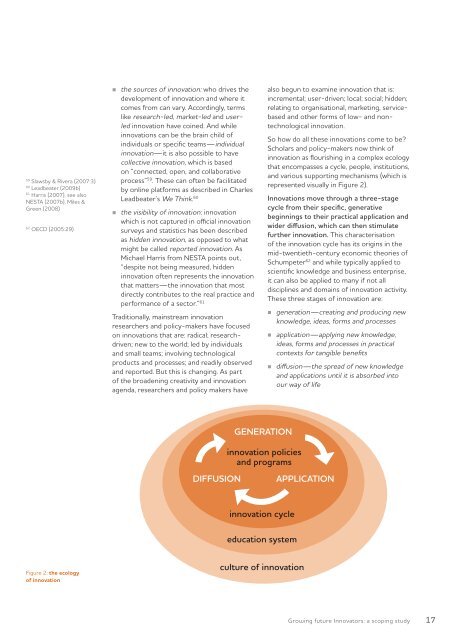GrowinG Future innovators - ARC Centre of Excellence for Creative ...
GrowinG Future innovators - ARC Centre of Excellence for Creative ...
GrowinG Future innovators - ARC Centre of Excellence for Creative ...
You also want an ePaper? Increase the reach of your titles
YUMPU automatically turns print PDFs into web optimized ePapers that Google loves.
59 Slawsby & Rivera (2007:3)<br />
60 Leadbeater (2009b)<br />
61 Harris (2007), see also<br />
NESTA (2007b), Miles &<br />
Green (2008)<br />
62 OECD (2005:29)<br />
Figure 2: the ecology<br />
<strong>of</strong> innovation<br />
the sources <strong>of</strong> innovation: who drives the<br />
development <strong>of</strong> innovation and where it<br />
comes from can vary. Accordingly, terms<br />
like research-led, market-led and userled<br />
innovation have coined. And while<br />
innovations can be the brain child <strong>of</strong><br />
individuals or specific teams—individual<br />
innovation—it is also possible to have<br />
collective innovation, which is based<br />
on “connected, open, and collaborative<br />
process” 59 . These can <strong>of</strong>ten be facilitated<br />
by online plat<strong>for</strong>ms as described in Charles<br />
Leadbeater’s We Think. 60<br />
the visibility <strong>of</strong> innovation: innovation<br />
which is not captured in <strong>of</strong>ficial innovation<br />
surveys and statistics has been described<br />
as hidden innovation, as opposed to what<br />
might be called reported innovation. As<br />
Michael Harris from NESTA points out,<br />
“despite not being measured, hidden<br />
innovation <strong>of</strong>ten represents the innovation<br />
that matters—the innovation that most<br />
directly contributes to the real practice and<br />
per<strong>for</strong>mance <strong>of</strong> a sector.” 61<br />
Traditionally, mainstream innovation<br />
researchers and policy-makers have focused<br />
on innovations that are: radical; researchdriven;<br />
new to the world; led by individuals<br />
and small teams; involving technological<br />
products and processes; and readily observed<br />
and reported. But this is changing. As part<br />
<strong>of</strong> the broadening creativity and innovation<br />
agenda, researchers and policy makers have<br />
DIFFUSION<br />
GENERATION<br />
innovation policies<br />
and programs<br />
innovation cycle<br />
education system<br />
cities / living<br />
culture <strong>of</strong> innovation<br />
also begun to examine innovation that is:<br />
incremental; user-driven; local; social; hidden;<br />
relating to organisational, marketing, servicebased<br />
and other <strong>for</strong>ms <strong>of</strong> low- and nontechnological<br />
innovation.<br />
So how do all these innovations come to be?<br />
Scholars and policy-makers now think <strong>of</strong><br />
innovation as flourishing in a complex ecology<br />
that encompasses a cycle, people, institutions,<br />
and various supporting mechanisms (which is<br />
represented visually in Figure 2).<br />
Innovations move through a three-stage<br />
cycle from their specific, generative<br />
beginnings to their practical application and<br />
wider diffusion, which can then stimulate<br />
further innovation. This characterisation<br />
<strong>of</strong> the innovation cycle has its origins in the<br />
mid-twentieth-century economic theories <strong>of</strong><br />
Schumpeter 62 and while typically applied to<br />
scientific knowledge and business enterprise,<br />
it can also be applied to many if not all<br />
disciplines and domains <strong>of</strong> innovation activity.<br />
These three stages <strong>of</strong> innovation are:<br />
generation—creating and producing new<br />
knowledge, ideas, <strong>for</strong>ms and processes<br />
application—applying new knowledge,<br />
ideas, <strong>for</strong>ms and processes in practical<br />
contexts <strong>for</strong> tangible benefits<br />
diffusion—the spread <strong>of</strong> new knowledge<br />
and applications until it is absorbed into<br />
our way <strong>of</strong> life<br />
APPLICATION<br />
Growing future Innovators: a scoping study 17




![Plebiscite (Riegert chapter) revised FINAL [Feb 14].pdf](https://img.yumpu.com/8710373/1/190x245/plebiscite-riegert-chapter-revised-final-feb-14pdf.jpg?quality=85)